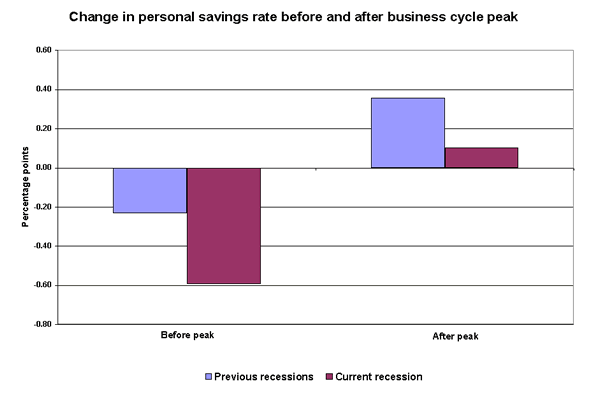Snapshot for April 9, 2003.
War anxiety and the struggling economy
Anxieties over the war in Iraq are often blamed for the struggling economy, but in actuality the economy is weak because consumers lack the resources, not the willingness to consume, and, with no new consumers in sight, businesses have little incentive to invest.
If anxiety over the economy or the war led consumers to buy less, households should have reduced their consumption more than during previous recessions. But the numbers show that consumers are buying more than one would expect during a recession.

Typically, households consume more, and save less than usual during the six quarters leading up to the peak of a business cycle. Likewise, consumers spend less, and save more than usual in the six quarters after a recession began. For all prior recessions, the savings rate was 0.2 percentage points below its trend in the year and a half before a recession, and 0.4 percentage points higher than its trend in the year and a half following the business cycle peak. In the current recession, the savings rate was much further below its trend prior to the recession, indicating that people consumed more than they previously had. And also, the savings rate was only 0.1 percentage points above its trend after this recession began, showing that consumers continued to shop more than during previous recessions (see figure above). Consumers maintained a higher level of consumption throughout this recession than they did in previous recessions, which also implies that the uncertainty over war in Iraq did not have a negative effect on consumption.
Even if consumers wanted to buy more products, businesses could increase their production without having to invest more to meet demand. Since the recession began in March 2001, businesses have used less than 80% of the capacity available to them. In February 2003, businesses used only 76% of their capacity. Since economists usually consider 84-85% of capacity utilization to be “full capacity,” businesses are still a long way away from fully utilizing their full resources. With this much excess capacity, businesses are not in a hurry to invest more.
Note for graph: All figures are in percentage points. Figures are the average difference from the trend savings rate for the six quarters prior to the business cycle peak or the six quarters following the business cycle peak. The trend is calculated using a Hodrick-Prescott filter. Data for the personal savings rate is taken from the National Income and Product Accounts of the Bureau of Economic Analysis (BEA).
This week’s Snapshot by EPI economist Christian E. Weller with research assistance from Matthew Walters.
Check out the archive for past Economic Snapshots.
